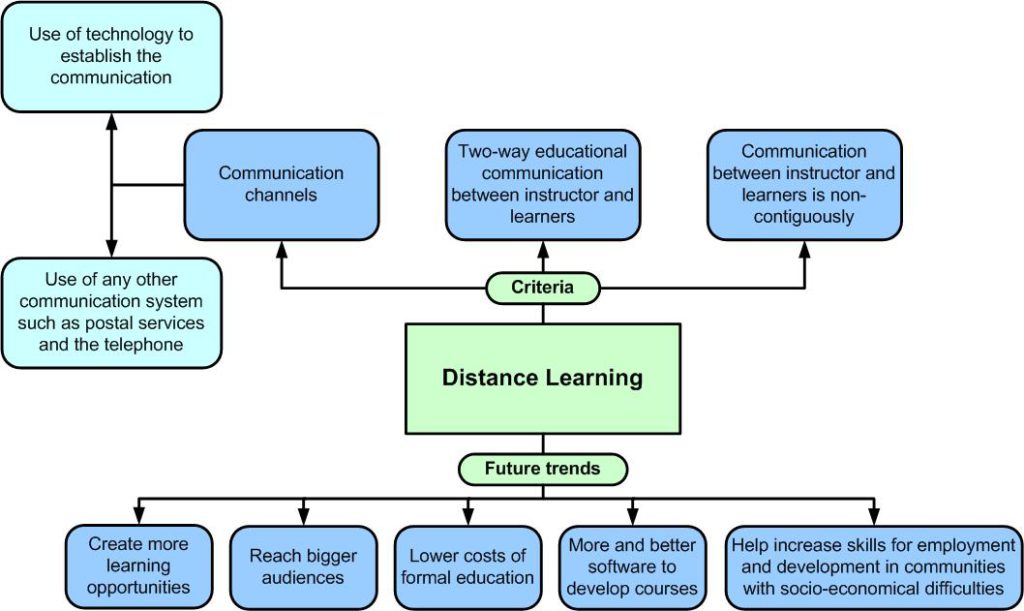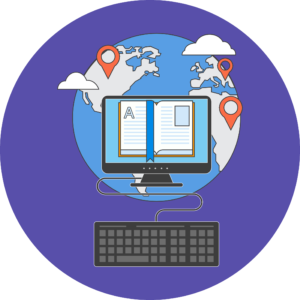Meaning of Distance Learning – Different Models and Future Trends

My Initial Thoughts about Distance Education
Initially I thought the meaning of distance learning was the learning methodology where the instructor and the learners are separated geographically and interact asynchronously.
In this methodology, learners access the course resources via internet, or as it used to be, via radio, TV, or postal services.
Basically, interactions between the instructor and the learners occur via a telecommunication system such as the internet, telephone, postal correspondence, among many others depending on the technology available.
The Extend of Distance Education
However, my view of distance learning is starting to consider another element such as the “institutionally based of the educational organizations delivering distance education” (Simonson, Smaldino, & Zvacek, 2015).
I personally think that any non-accredited course delivered with the distance methodology could be considered an important part of the distance education system. But according to Simonson et al. (2015) distance courses from a non-institutionalized organization are considered as self-study.
Even though I am not pretending to contradict the institutionalized based component of distance learning, I still think distance education courses from non-academic organizations are an important player in the evolution of distance education.
Now there are available so many courses we can take to get a new knowledge or advanced our existing skills without the high costs that can characterized some of the formal institutionalized education.
I have taken distance courses with the e-Learning methodology about topics such as instructional design, finance, teaching adult learners, and writing for the web that are from non-institutionalized organizations but that still offered good quality courses from subject matter experts.
My Preferred Definition of Distance Education
As a result, my revised definition of distance learning now as evolved to include the criteria offered by Garrison and Shale (as cited in Simonson, Smaldino, & Zvacek, 2015) where distance education is the learning methodology where there is a two-way educational communication between instructor and learners that occurs non-contiguously with the use of technology to establish that two-way communication or any other communication system in those cases where technology is limited.
This broader definition of distance learning could potentially be more inclusive to future trends of distance education.
Distance education will continue to provide “learning opportunities using mass-produced courseware to a mass market” (p. 35) as expressed by Edwards (as cited in Simonson, Smaldino, & Zvacek, 2015). And this is something we currently see with MOOCs (Massive Open Online Courses).
Models of Distance Learning
1. Online Courses
How much content is delivered online?
More than 80% of the course is delivered online (Burns, 2011).
How much separation is there between the learner and the facilitator?
Learners and instructors are separated by geography and time. In this model, courses can be delivered in different time and different place (DT-DP) which is called asynchronous online earning. And could also be delivered in same time and different place (ST-DP) which is called synchronous inline learning (Simonson, Smaldino, & Zvacek, 2015).
In what ways is technology used in this model?
Web 2.0 (blogs, wikis, podcasts, social networking sites) are used to allow students share information and to collaborate.
Learning Management Systems (LMS) are used to host course content, to allow students participate in discussion forums, access grades, and load assignments.
Pros:
- Saving travel time for instructors and learners.
- Learners can work on their courses according to their own schedules.
- Instructors can handle a larger number of students.
Cons:
- Learners might have problems comprehending course information that is technical, quantitative, or scientifically oriented.
- Difficulties to modify lecture plans and content based on instant feedback from learners.
- The physical and time separation between instructor and learner can introduce delays in addressing problems. (Hannay & Newvine, 2006).
What factors need to be considered when implementing this model?
- IT Infrastructure: proper Internet, bandwidth, and LMS. Training for the academic staff and students on using the tools and motivate them to adopt eLearning.
- Upgrade and review the existing curriculum or training to see if it can be converted into eLearning (Kumar, 2014).
2. Blended/Hybrid Courses
How much content is delivered online?
Between 30-79% of the course content is delivered online and the rest is delivered with face-to-face interactions in the classroom (Burns, 2011).
How much separation is there between the learner and the facilitator?
This type of model is a combination of online and face-to-face. The instructor and learners are separated by different places (DP) in the online part and could still be separated by different time (DT) although sometimes could still interact synchronously or at the same time (Simonson, Smaldino, & Zvacek, 2015).
In what ways is technology used in this model?
- Blogs, wikis, and websites are used to allow students build ePortfolios and work on projects to deep the learning experience.
- LMS in hybrid courses allow instructor and peer review (Bragg & Swenson, 2009).
Pros:
- Having some classroom sessions retains the class social dynamic and its sense of connection among students and faculty, while decreasing the amount of scheduled class time and commuting time for students and faculty.
- More flexible schedule and better ability to work from different locations.
- More efficient use of classroom space which could increase classroom availability (University of Washington Bothell, n.d.).
Cons:
- The designing phase may take a big effort in order to maximize active learning and student engagement in both environments (online and classroom) (University of Washington, 2013).
- Some learners will miss the social stimulation of face-to-face sessions (Zappia, n.d.).
What factors need to be considered when implementing this model?
- Reliability of technology.
- Technical support for academics and students.
- Network security.
- Availability of resources and learning materials.
- Methods of evaluation and assessment.
- Course objectives.
- Optimal connection between classroom and online activities (Morote, Wittmann, Kelly, 2007).
3. Web-Facilitated Courses
How much content is delivered online?
Between 1-29% is delivered online and the major part of the content is delivered in the conventional classroom (Burns, 2011).
How much separation is there between the learner and the facilitator?
There is minimal physical and time separation between instructors and learners.
In this model the separation comes from the content and the resources of the course that are in a separate or remote location. In this case, that small portion of the course content and resources are accessed through the web in the classroom with the instructor or at a different time and place than the conventional class meeting (Simonson, Smaldino, & Zvacek, 2015).
In what ways is technology used in this model?
Mobile technology (laptops, tablets, iPads, mobile phones) to allow learners access online content, educational games, and simulations (Johnson, Adams, Estrada, & Freeman, 2015).
Pros:
- Synchronous peer and instructor interactions allow students to receive immediate individual feedback and mentorship.
- Faculty members can gauge their students’ level of engagement, attentiveness, and comprehension.
- Most faculty members are very familiar and comfortable with this format (University of Washington, 2013).
Cons:
- Students must arrange their schedules for classroom sessions, which may limit access to classes for those working.
- Faculty members cannot provide individualized or customized learning experiences in large classes.
- Students may be intimidated by asking clarification questions in person during class (University of Washington, 2013).
What factors need to be considered when implementing this model?
- Technology should be simple enough for the students to be engaged.
- To ensure that students are not distracted by new technologies, forming habits around technology is fundamental. The first utilization should provide a model for future interactions (Geer, 2009).
The Future of Distance Learning 
The future of distance education will depend on:
- Information and communication technology that will impact the possibility to reach bigger audiences.
- Better software to facilitate the development of online courses.
- The willingness from educational institutions to democratize the education in order to offer more learning opportunities.
It will be ideal and it will bring huge benefits for the global economy if learners from different parts of the world could access with distance education accredited courses at the lowest possible cost in order to raise their skills for employment, and thus improve their quality of life and benefit their communities.
Distance learning keeps growing but still there is so much to do to engage people all over the world, and especially those communities that are facing difficulties and lower levels of quality of life. Education could change their situation but we still need to make education accessible to everyone.
What is your favorite distance learning model? Feel free to leave your comments below.
See you next time 🙂
Thais
References
Bragg, C.K. & Swenson, P. (2009). Online and hybrid courses: maximizing student learning. In T. Bastiaens, J. Dron & C. Xin (Eds.), Proceedings of E-Learn: World Conference on E-Learning in Corporate, Government, Healthcare, and Higher Education 2009 (pp. 843-846). Chesapeake, VA: Association for the Advancement of Computing in Education (AACE).
Burns, M. (2011). Distance education for teacher training: modes, models, and methods. Retrieved from http://idd.edc.org/resources/publications/modes-models-and-methods
Geer, R. (2009). Strategies for blended approaches in teacher education. In: Stacey, E., and Gerbic, P. (Eds.) Effective Blended Learning Practices: Evidence-based Perspectives in ICT-Facilitated Education, Information Science Reference: Hershey, NH.
Hannay, M., Newvine, T. (2006). Perceptions of distance learning: a comparison of online and traditional learning. Journal of Online Learning and Teaching. Retrieved from http://jolt.merlot.org/05011.htm
Johnson, L., Adams Becker, S., Estrada, V., and Freeman, A. (2015). NMC Horizon Report: 2015 K-12 Edition. Austin, Texas: The New Media Consortium.
Kumar, K. (2014). 4 factors you need to consider before implementing e-learning. [Web post]. Retrieved from http://blog.commlabindia.com/elearning-design/factors-before-implementing-elearning
Morote, E.S., Wittmann, H. & Kelly, T. (2007). What really matters for faculty to develop and implement hybrid/blended courses? In R. Carlsen, K. McFerrin, J. Price, R. Weber & D. Willis (Eds.), Proceedings of Society for Information Technology & Teacher Education International Conference 2007 (pp. 1085-1089). Chesapeake, VA: Association for the Advancement of Computing in Education (AACE).
Simonson, M., Smaldino, S., & Zvacek, S. (2015). Teaching and learning at a distance: Foundations of distance education. Charlotte, NC: Information Age Publishing.
University of Washington Bothell. (n.d.). Hybrid learning benefits. [Web post]. Retrieved from http://www.bothell.washington.edu/learningtech/hybrid-and-online-learning/hybrid-learning/about-hybrid-learning/benefits
University of Washington. (2013). Exploring the pros and cons of online, hybrid, and face-to-face class formats. Retrieved from http://www.washington.edu/provost/files/2012/11/edtrends_Pros-Cons-ClassFormats.pdf
Zappia, S. (n.d). Pros & cons of hybrid courses. [Web post]. Retrieved from http://education.seattlepi.com/pros-cons-hybrid-courses-3288.html
